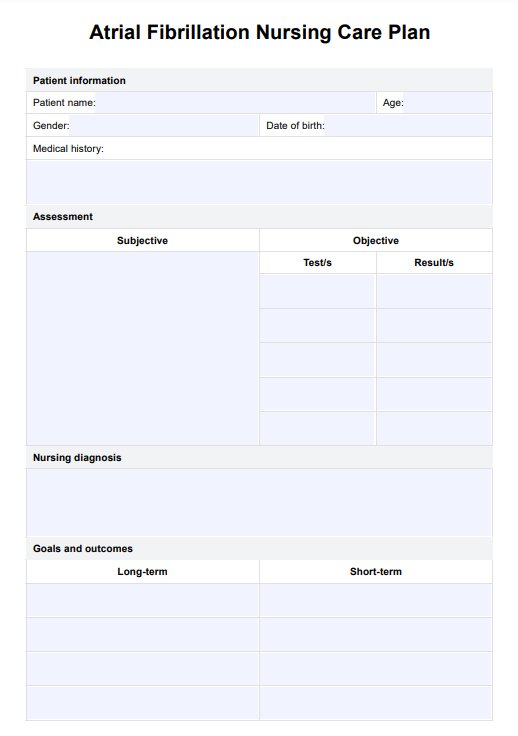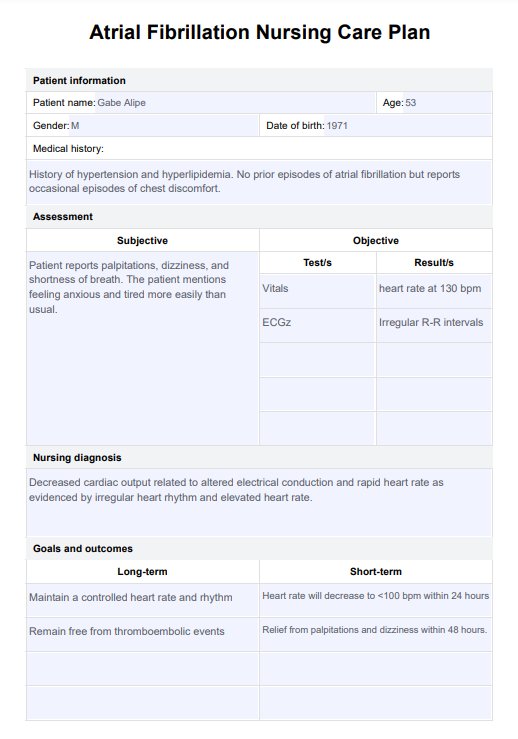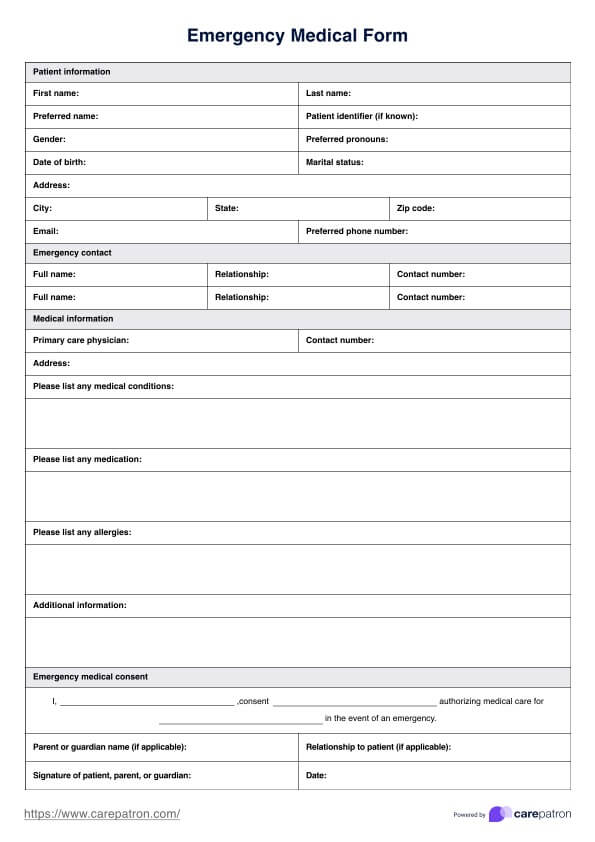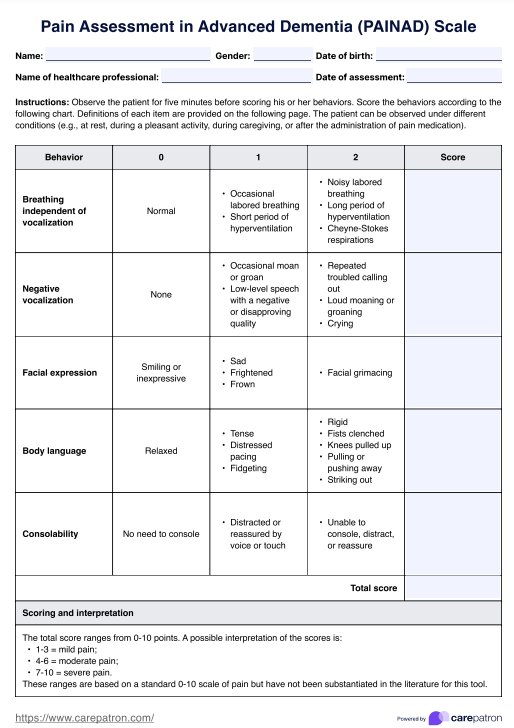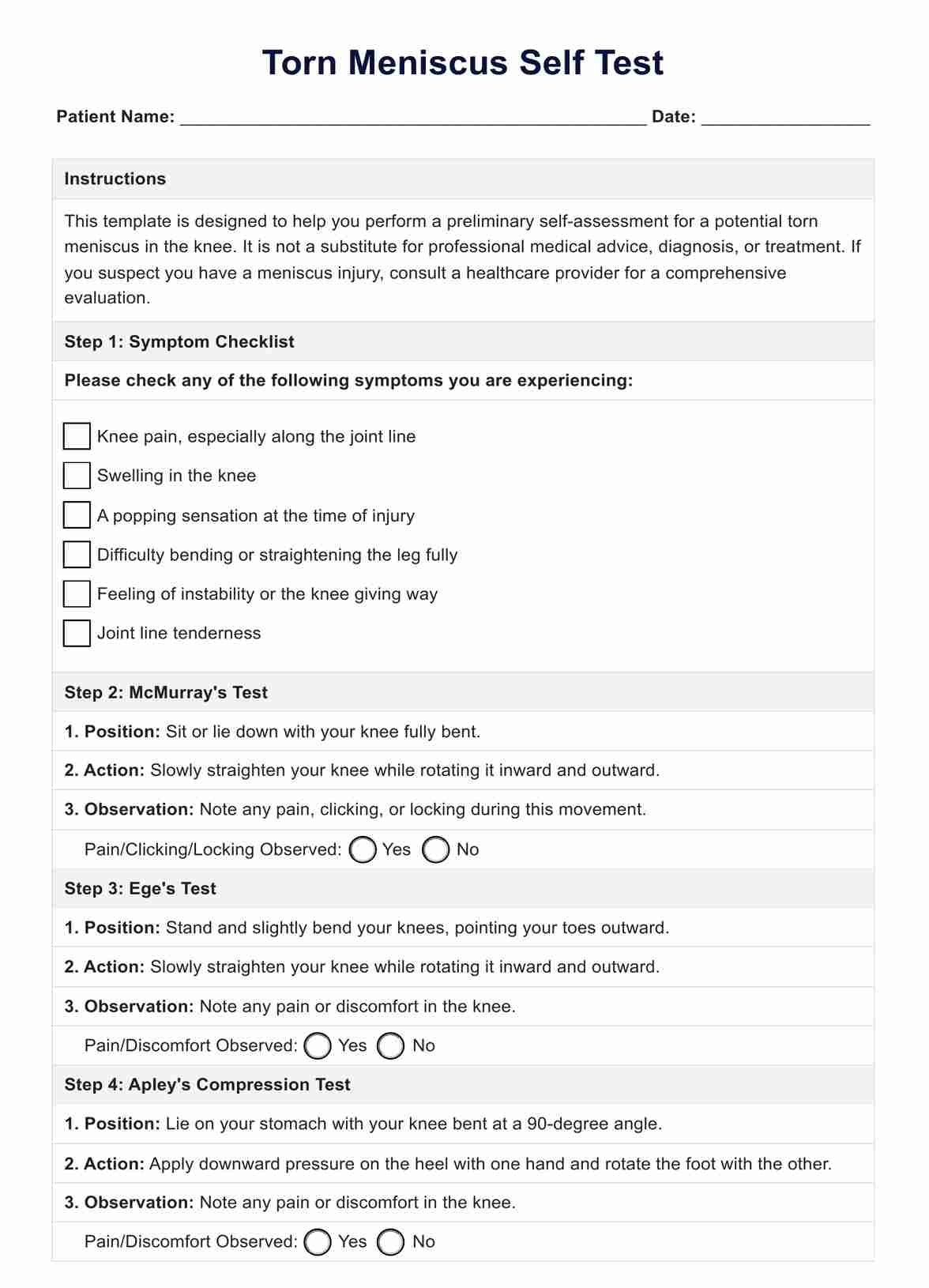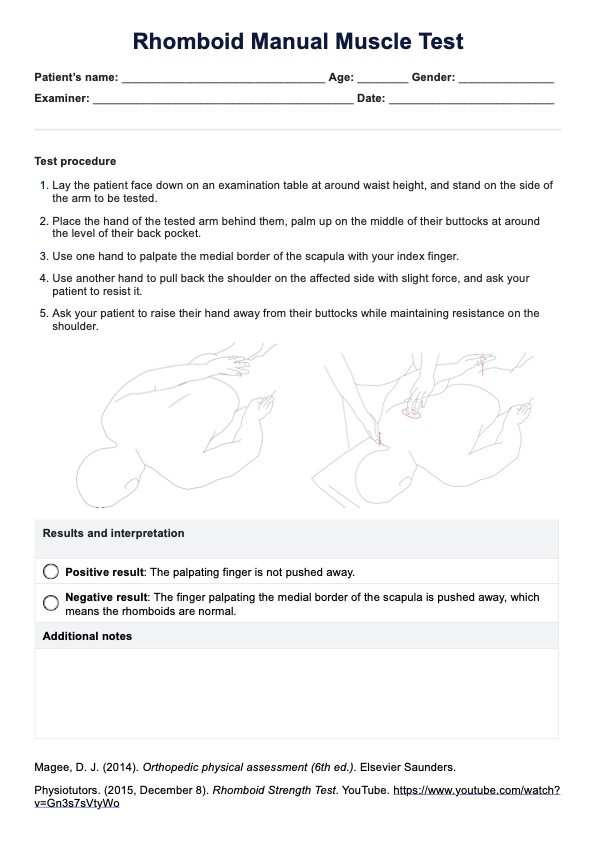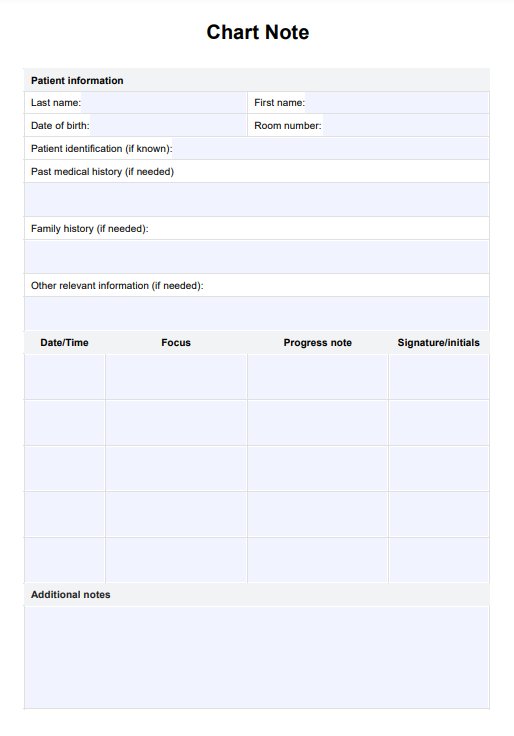Atrial Fibrillation Nursing Care Plan
Streamline patient care with our Atrial Fibrillation Nursing Care Plan Template - a comprehensive guide for effective management and treatment.


What is atrial fibrillation (AFib)?
Atrial fibrillation, or AFib, is a common heart rhythm disorder (cardiac arrhythmia) characterized by irregular and often rapid beating of the heart's upper chambers, known as the atria. Normally, the heart contracts and relaxes in a regular rhythm to pump blood effectively throughout the body. However, in AFib, the electrical signals that coordinate the pumping action of the cardiac muscle become chaotic. Instead of beating coordinately, the atria fibrillate or quiver, causing an irregular heartbeat.
This irregularity disrupts the heart's ability to pump blood efficiently (decreased cardiac output). As a result, blood flow may become sluggish or turbulent in the atria, leading to blood clot formation. These clots can break loose and travel through the bloodstream, potentially causing blockages in blood vessels supplying the brain. This can result in a stroke and lead to other problems, such as persistent atrial fibrillation, coronary artery disease, or even congestive heart failure.
AFib can be a valvular disease or a non-valvular disease, which means it can be caused by a problem with the heart valves or by other factors such as age, high blood pressure, and underlying heart conditions.
People with AFib may experience symptoms like palpitations (a rapid or irregular heartbeat sensation), shortness of breath, fatigue, chest pain or discomfort, dizziness, and a feeling of fluttering or pounding in the chest. Several risk factors can contribute to AFib, including age, high blood pressure, heart disease, diabetes, obesity, excessive alcohol consumption, thyroid problems, and other chronic conditions. In some cases, the cause may not be identifiable, and AFib is termed "idiopathic."
Atrial Fibrillation Nursing Care Plan Template
Atrial Fibrillation Nursing Care Plan Example
What is an Atrial Fibrillation Nursing Care Plan Template?
An Atrial Fibrillation Nursing Care Plan Template is a structured framework nurses use to assess, plan, implement, and evaluate care for patients with atrial fibrillation. This template serves as a guide for nurses to provide comprehensive and individualized care tailored to each patient's specific needs.
Typically, this template contains sections for assessment, diagnosis, planning, interventions, rationale, and evaluation. Nurses can use this template to document patient data, identify potential risks, and develop a nursing care plan to manage symptoms and prevent complications.
Carepatron has made an easy-to-use and free Atrial Fibrillation Nursing Care Plan Template structured to help nurses provide quality care to AFib patients. This template can also be customized to fit the patient's unique needs and circumstances.
How does it work?
Follow these steps to use our printable Atrial Fibrillation Nursing Care Plan Template:
Step 1: Obtain the Atrial Fibrillation Nursing Care Plan Template
Download the Atrial Fibrillation Nursing Care Plan Template using the link on this page. It's also accessible through the Carepatron app.
Step 2: Collect patient information
Before filling out the template, gather all necessary information regarding the patient's medical history, current health status, medication regimen, and any existing conditions related to atrial fibrillation. Don't forget to consider vital signs, rhythm monitoring, and any relevant lab results as well.
Step 3: Complete the care plan
Fill in the sections of the template using the information collected from your patient assessment. Be sure to use complete sentences and specific details to outline the patient's risk factors, potential complications, and the interventions or preventive measures that should be implemented.
Step 4: Reevaluate regularly
As the patient's condition progresses, it is crucial to regularly reassess their risk of complications related to atrial fibrillation and adjust the nursing care plan accordingly. This continuous evaluation will ensure that effective strategies are implemented to manage their condition appropriately.
Components of an effective nursing care plan for AFib
An effective nursing care plan for AFib is essential to ensure the safety and well-being of patients. This plan should encompass the following key components:
Assessment
The initial assessment for atrial fibrillation involves a comprehensive evaluation of the patient's health status, focusing on both subjective and objective data. Nurses should review the patient's medical history, paying close attention to any underlying conditions that may contribute to AFib, such as hypertension, heart disease, or hyperthyroidism.
It’s also important to assess the patient's symptoms, including palpitations, shortness of breath, or chest pain. Additionally, nurses should inquire about the patient's history of stroke, heart attacks, or thromboembolic events, as these can increase the risk associated with AF. Vital signs, including heart rate and rhythm and complete blood count, should be carefully assessed, and any irregularities should be documented.
Nursing diagnosis
After completing the assessment, nurses should analyze the data to determine appropriate nursing diagnoses. These should specifically address the risk factors associated with atrial fibrillation, guiding the creation of relevant interventions.
Common nursing diagnoses may include:
- Risk for decreased cardiac output related to impaired atrial filling and increased risk of thromboembolism.
- Impaired gas exchange related to decreased cardiac output or pulmonary congestion.
- Knowledge deficit related to AFib diagnosis, treatment options, and self-care management.
Goals and outcomes
The care plan should outline both short-term and long-term goals to monitor the patient's progress and assess the effectiveness of interventions. Goals need to be specific, measurable, achievable, relevant, and time-bound (SMART).
For instance, a short-term goal could be to achieve a stable heart rate and rhythm within 24 hours through pharmacological interventions. A long-term goal may be to prevent AFib recurrence by educating the patient on lifestyle modifications, such as managing stress and maintaining a healthy weight.
Interventions
Nursing interventions for patients with atrial fibrillation should focus on promoting optimal heart function and preventing complications. Actions may include:
- Providing education on lifestyle modifications, such as dietary changes, exercise, and smoking cessation.
- Administering prescribed anticoagulants or antiarrhythmic medications and monitoring for side effects.
- Conducting regular assessments of heart rhythm and vital signs.
- Collaborating with the healthcare team to develop a comprehensive management plan tailored to the patient's needs.
Involving patients in their care plan is vital, empowering them to take an active role in managing their condition.
Rationale
Understanding the rationale behind each intervention is crucial for effective patient care. Evidence-based practices should guide nursing actions.
For example, educating patients about the importance of anticoagulation therapy is vital, as it helps prevent strokes by reducing the risk of thrombus formation. Additionally, encouraging lifestyle changes can improve overall cardiovascular health.
Evaluation
The final step in the nursing care plan for atrial fibrillation is evaluation. Nurses should consistently assess the patient's response to the implemented interventions and make necessary adjustments.
Collaboration with other healthcare professionals, including cardiologists and pharmacists, is essential for a coordinated approach to patient care. Regular follow-ups and patient education should also be prioritized to ensure ongoing management of atrial fibrillation and prevention of complications.
When would you use this template?
The Atrial Fibrillation Nursing Care Plan Template is essential for healthcare professionals specializing in cardiology, emergency medicine, and general medical care. It is particularly beneficial in the following scenarios:
- Acute atrial fibrillation episodes: During emergencies where a patient presents with a sudden onset of atrial fibrillation, this template helps establish a care plan quickly, ensuring prompt and effective treatment.
- Long-term management: The template aids in developing a comprehensive management plan for patients with chronic atrial fibrillation. This plan includes regular monitoring, medication management, and lifestyle modifications to prevent exacerbations.
- Post-diagnosis care: After a patient is diagnosed with atrial fibrillation, the template outlines a step-by-step approach for initial care and education, which is crucial for understanding and compliance.
- Multidisciplinary settings: In environments where multiple healthcare providers are involved in patient care, the template serves as a unified document, enhancing communication and coordination among team members.
- Patient education and engagement: The template is also a valuable resource for educating patients about their condition, treatment options, and self-care strategies, fostering a collaborative approach to health management.
For a variety of effective solutions, consider our nursing care plan and Care Plan Template, offering diverse approaches to client management.
Treatment options for atrial fibrillation
Atrial fibrillation treatment aims to restore cardiac function. This includes controlling the heart's rhythm and rate, restoring normal sinus rhythm, preventing blood clots, managing underlying conditions, and reducing the risk of complications. This may involve:
- Medications to control heart rate and rhythm (like calcium channel blockers)
- Blood thinners to prevent clot formation (anticoagulation therapy)
- Lifestyle changes such as maintaining a healthy diet, regular exercise, and managing stress
- In some cases, procedures like cardioversion (to restore normal heart rhythm) or catheter ablation (to correct the heart's electrical signals) are also used.
Managing AFib requires a comprehensive approach involving healthcare professionals, including cardiologists, electrophysiologists, nurses, and other specialists. Regular monitoring, adherence to treatment plans, and lifestyle modifications are essential in managing AFib and reducing associated risks.
Commonly asked questions
Nursing interventions for atrial fibrillation include several key actions: administering prescribed medications like beta-blockers, calcium channel blockers, or anticoagulants based on the patient's condition; regularly monitoring vital signs such as blood pressure, heart rate, and oxygen saturation to assess treatment response and detect complications; and conducting a thorough assessment of symptoms like chest pain, shortness of breath, dizziness, and fatigue to evaluate the condition's severity and ensure appropriate care.
The SMART goal for atrial fibrillation management is to maintain a normal heart rate, prevent future episodes, reduce the risk of stroke and other complications, and enhance overall quality of life. This can be achieved through lifestyle changes like a healthy diet, regular physical activity, stress management, and quitting smoking.
Some key areas that nurses should monitor include the patient's heart rate and rhythm, blood pressure, oxygen saturation levels, and any potential signs of complications such as chest pain or shortness of breath.

.jpg)
